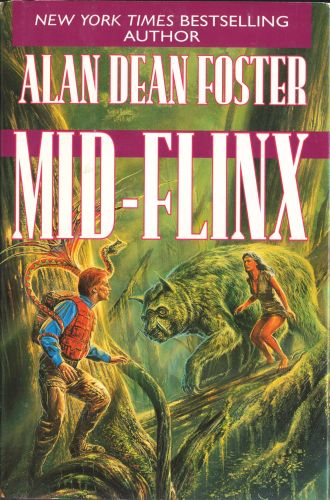

|
| Cover art by Bob Eggleton |
| MID-FLINX Alan Dean Foster New York: Del Rey Books, November 1995 | Rating: 4.5 High |
|||
| ISBN-13 978-0-345-38374-7 | ||||
| ISBN-10 0-345-38374-5 | 344pp. | HC | $22.00 | |
Flinx at times has dreams, or more than dreams. Knowing they relate to his erratic Talent, which he desires to conceal, he seldom speaks of them. But near the beginning of this novel, he relates the content of one disturbing dream to a Father Bateleur.1 It proves a fortuitous revelation. Explaining why would be a spoiler. I will reveal the content of the dream — but vaguely, in Foster's words:
Anxiety. Uncomprehension. Flinx swam in a pool of shared glaucous concern, trying to keep his conscious unconscious from drowning in confusion, unable to offer succor or solution. But there was a possible solution. Incredibly complex, difficult beyond imagining, the legacy of great thinkers long since departed, it hovered tantalizingly on the edge of his understanding. That was because he was not yet ready. Not yet ready, but incontestably a part of it. – Page 160 |
Midworld was the second novel by Alan Dean Foster that I read. It posits a planet so boisterous and fecund with life that a jungle has taken over every inch of land except the peaks of the highest mountains, and is encroaching even there. And this is no ordinary jungle; it is hundreds of meters deep, its canopy supported by trees as tall, with girths no tree of Earth can match. Its ecology comprises seven levels, each populated with colorfully bizarre animal and plant species, many of them deadly. Above the treetops fly winged predators of many types, while the lowest level hides monsters that beggar the descriptive power of English. Yet humans are here, descended apparently from the crew of a crashed starship. They have adapted to the world forest, and even thrive on its third level. The plot of that novel concerns the failed attempt to set up a commercial outpost that would exploit the planet's biotic richness. It failed in dramatic fashion, defeated by the forest and a couple of local heroes named Born and Losting.
In this novel, Foster brings his best-known character Flinx to Midworld. Mid-Flinx, however, starts on the civilized world of Samstead. Flinx has gone there for some down time. While dining in a restaurant, he inadvertently attracts the attention of a local thug to Pip, his ever-present Alaspinian mini-dragon. This joker, Jack-Jax Coerlis, fancies himself a collector of exotic life forms, and he decides Pip is for him. Flinx disagrees. He and Pip escape the restaurant, but Coerlis pursues. There's a starship chase which ends when Flinx goes to warp well enough ahead of Coerlis's ship to lose him. He tells the nav system to head for the first habitable world on his heading. So he ends up at Midworld by chance, on arrival finding its Commonwealth record is next to nonexistent. Puzzled, he queries his ship further.
"It's an odd entry in the files, sir. There's virtually nothing in the way of description beyond the fact that it is Earthlike and habitable. It's more of a statistic than a realized place." – Page 63 |
But he takes a shuttle down and lands on a nearly bare mountaintop. Soon he and Pip are heading into the forest, avoiding predators and poisonous plants mostly by luck — until he's dangling below a branch, about to be eaten by a sort of gigantic orchid. But he gets a shock: two slothlike creatures appear, and they are debating whether or not he is a person — in Commonwealth language! They finally agree there's a reasonable chance he is, and cut the vines drawing him into the orchid. Then he gets an even greater shock, as a young woman in a green garment and her companion furcot approach. This furcot (see the cover illustration) is a larger version of the two debaters. The woman's name is Teal. She, it turns out, has lost her mate Jerah to a diverdaunt and cannot find the way back to her Home Tree. Flinx decides he can help her. Teal has told him the legend of the failed commercial venture; its location matches that of a metallic signature his ship picked up from orbit. He can use his handheld locator to guide them there; Teal thinks she can then find the Home Tree.
They are three days on their way, progressing well with the help of the furcots, when a most unwelcome predator shows up. This is not a native of Midworld, however. It bears the name of Jack-Jax Coerlis. The thug has used his wealth to determine Flinx's likely destination, and showed up there with his little band of employees. A few of those employees have fallen to Midworld perils, but enough remain to capture Flinx, Teal and her two children and to secure Pip in a venom-proof bag. (The furcots, fortuitously, remain out of sight.) Coerlis is about to make Flinx step off the branch when a new party enters the picture. The rest you can discover for yourself.
I don't feel this novel is quite up to the quality of Midworld. But despite the author having telegraphed Flinx's next mission, the story provides an adequate sequence of perils for him and generally coheres well. Also, as befits a novel set on Midworld, it is populated with a satisfyingly bizarre and threatening collection of life forms. In short, it's worthy of one notch below top marks.2

 To contact Chris Winter, send email to this address.
To contact Chris Winter, send email to this address.